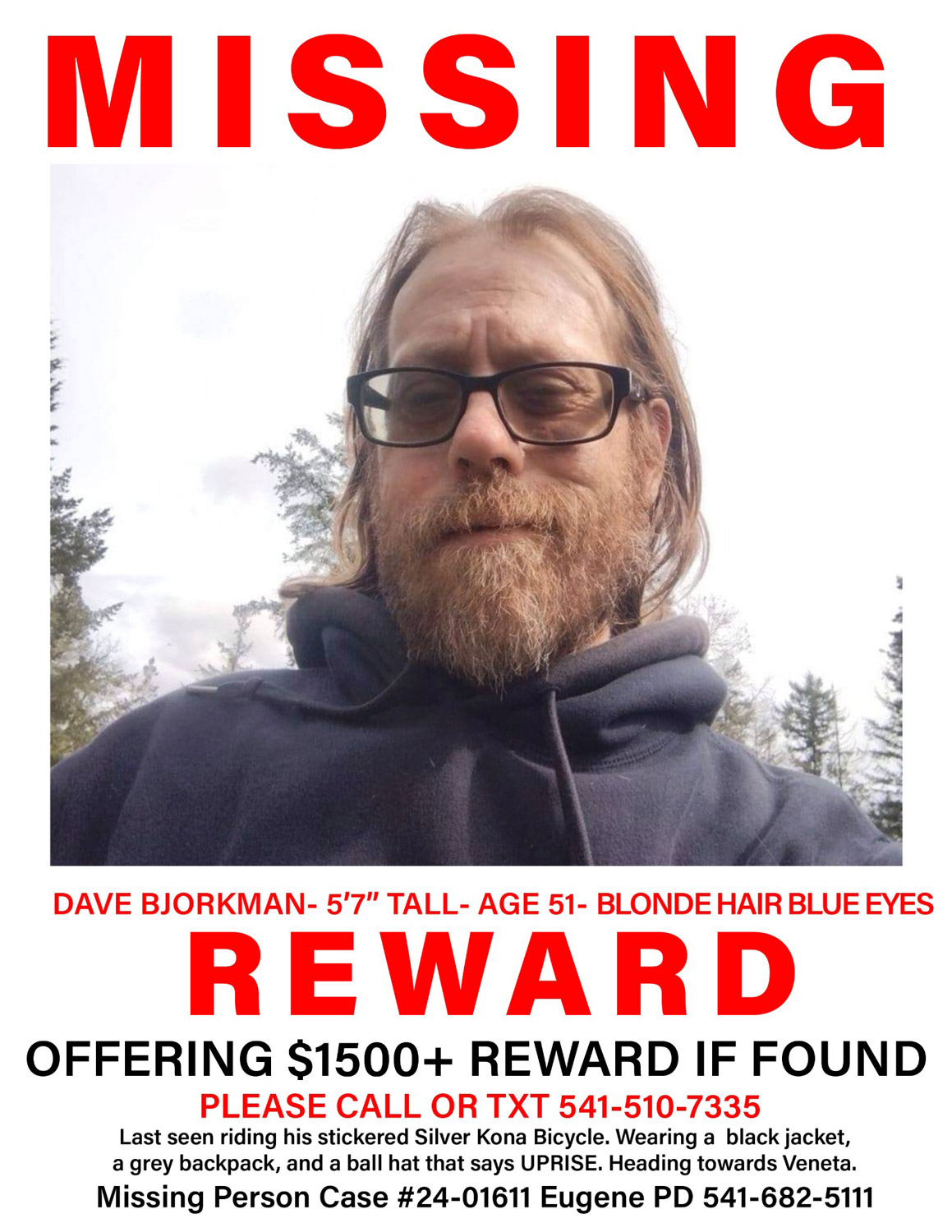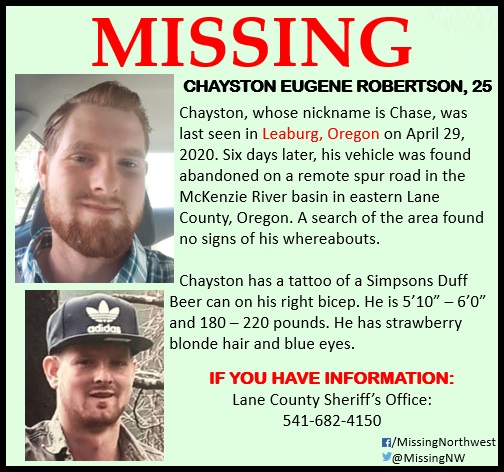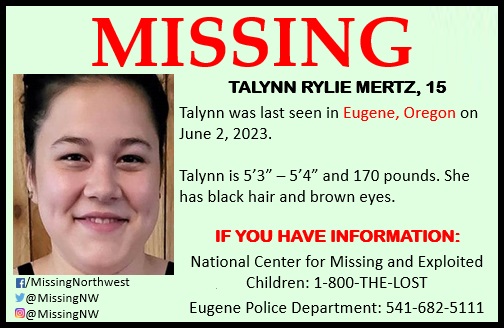The latest news stories and stories of interest in the Willamette Valley from the digital home of Southern Oregon, from Wynne Broadcasting’s WillametteValleyMagazine.com
Monday, April 29, 2024
Willamette Valley Weather



Over 8,000 Participants in Eugene Marathon Sunday
Over 8,000 participants took to the roads as they ran across Eugene in the half and full marathon during the annual Eugene Marathon held Sunday morning in Eugene.
The Eugene Marathon is the Pacific Northwest’s largest marathon and takes place each spring on the last Sunday of April. The marathon and half marathon courses traverse through the communities of Eugene and Springfield, alongside the Willamette River, and on the same roads that the world’s best runners have competed on for over 50 years.
The race, which included both a half marathon and a full 26.2 mile marathon, started at 7 am and wound its way through the university district of Eugene and along the Willamette River. The race started and ended at Hayward Field. Proudly part of a long tradition in TrackTown USA. RESULTS: https://www.eugenemarathon.com/results

Oregon State Police and Linn County Sheriff’s Office Pursue Coburg Shooting Suspect — Results In Officer-Involved Shooting on Sunday
On Sunday, April 28, 2024, at approximately 3:00 p.m., Oregon State Troopers responded to the Coburg area to assist the Coburg Police Department and Lane County Sheriff’s Office with a reported shooting. The shooting in Coburg critically injured one of the involved individuals and a search ensued for the other involved suspect.

At approximately 6:00 p.m., a vehicle of interest in the Coburg shooting was reported as a driving complaint. The vehicle was located by Linn County Deputies, Lane County Deputies, and Oregon State Troopers. A pursuit ensued northbound on Interstate 5 from exit 209. After a successful deployment of spike strips to stop the suspect vehicle, the vehicle crashed along the shoulder of Interstate 5. At the crash scene, an officer-involved shooting occurred, involving the Linn County Deputies and OSP Troopers from the pursuit.
The driver of the suspect vehicle is deceased. A passenger in the suspect vehicle was also injured during the officer-involved shooting and was transported for treatment.
No law enforcement members were injured during these incidents. The Oregon State Police Major Crimes Team is investigating the Coburg shooting.
Pursuant to Linn County Use of Deadly Force (SB 111) protocols, the Albany Police Department is investigating the officer-involved shooting on Interstate 5, and any involved law enforcement members have been placed on paid administrative leave by their respective agencies. Any further information will be released by the Albany Police Department.
National Small Business Week Celebrated April 28 to May 4, 2024
There are far-reaching advantages to deciding to “shop local.” By supporting local businesses, you are in turn supporting your local economy; significantly more money stays in a community when purchases are made at locally owned – rather than nationally owned – businesses.

The U.S. Small Business Association and the U.S. Department of Labor report the positive impacts of small, independent businesses on local economies.
- Local businesses are more likely to utilize other local businesses such as banks, service providers, and farms.
- For every $100 you spend at local businesses, $68 will stay in the community.
- Independent retailers return more than three times as much money per dollar of sales to the community in which they operate than chain competitors. Independent restaurants return more than two times as much money per dollar of sales than national restaurant chains.
- Small businesses employ 77 million Americans and accounted for 65% of all new jobs over the past 17 years.
In addition to helping build the local economy, there are also notable intangible benefits that come from supporting businesses in your local community.
- Local businesses are owned and operated by your neighbors! They care about and are invested in the well-being of your community and its future.
- Local businesses are more accountable to their local communities and donate more money to non-profits.
- Supporting local businesses is good for the environment because they often have a smaller carbon footprint than larger companies.
It isn’t always the easiest or most convenient option to visit a local independent business rather than a large national chain that might be down the street. However, there are plenty of ways you can help support your local economy by thinking local first:
- Try the menu at a local restaurant for lunch or dinner
- Purchase a birthday present at a local gift shop
- Join a local gym
- Visit a local nursery or hardware store for your lawn and garden needs
- Get your car serviced at a local mechanic
- Visit a farmer’s market to purchase the ingredients for your family dinner.
Top 10 Reasons to Shop Local First
- To shape and preserve our distinctive community character
- Local competition and diversity leads to more product choices
- It keeps and recirculates money in our community
- You’ll help support local job and opportunity creation
- It reduces environmental impact locally
- Because local businesses reinvest in our community
- It strengthens the local economy
- Because the local businesses help fund local non-profits
- To ensure that tax dollars stay local
- It encourages community pride and ownership
So the next time you need to run out for some groceries or do a little shopping, seek out a local business and see what they have to offer! You could discover some great products and services while helping to build a strong and successful community around you.
When you invest money in your local economy, you’re not just helping local business owners — you’re also helping yourself. You’re making your town a better place to live in, with a rich character, thriving economy, and tightly knit community. And the more local businesses prosper, the more new ones will open, making it even easier to continue shopping locally in the future.
Join the conversation and tell us about a great local business in your community: info@willamettevalleymagazine.com
Firefighters Keep Eugene Commercial Fire Small
Eugene Springfield Fire responded to a fire in a downtown business in Eugene Sunday night. Firefighters were called to 191 E Broadway where a business owner reported seeing a fire starting on their security camera and called 911.

Thanks to the early notification, Firefighters were able to arrive quickly and contain the fire to a workbench without damaging the structure. Preliminary information suggests the fire was caused by a lithium battery, but the Fire Marshal’s office will investigate further.
The 46th annual “Take Back the Night” March began at the University of Oregon Thursday evening despite the rain.

Hundreds chanted in unison calling for the end of sexual and domestic violence. Marchers with the 46th annual Take Back the Night waved signs and cheered as they continued on their two-and-a-half-mile route.
As the crowd passed by buildings, people could be seen hanging out of apartment windows, whistling and screaming in support. People gathered on balconies, waving to the marchers. Some came out to the sidewalk and applauded the group as it passed by.
Take Back the Night is a global movement, meant as an opportunity for survivors and allies to find unity, and solidarity and to stand against sexual and domestic violence. It started as a way to raise awareness of the realities of sexual violence against women. The University of Oregon’s Women’s Center has been putting on the event annually since 1976.
LCSO Case #24-2123 — Suspect arrested after assaulting roommate and responding deputies
On April 25th, 2024, Lane County Sheriff’s deputies responded to the report of an assault that had just occurred at an adult foster care facility in the 90700blk of Prairie Rd. in Eugene. Deputies learned that a resident, 46-year-old Levi Nelson, was being violent with other residents and had intentionally struck another resident in the face.
Upon arrival, deputies attempted to speak with Nelson at which time he tried to grab one of the deputy’s tasers from her duty belt. The deputy took hold of his arm at which time he pulled away and then began striking her in the head/neck area with a closed fist. Nelson grabbed hold of another deputy’s holstered firearm as they struggled to get him under control. Deputies were able to eventually overpower Nelson and get him into custody without any serious injuries being sustained by any of the involved parties.
Nelson was transported and lodged at the Lane County Jail on charges including Physical Harassment and two counts of Assault on a Public Safety Officer.
Lane County Public Health Seeing Rise In Pertussis Cases
Lane County Public Health (LCPH) has confirmed a new case of pertussis (also known as whooping cough) in a recent uptick in cases. This new case closely follows 12 recently reported cases and brings the total to 13 pertussis cases in April 2024. Several of the recent cases are not linked.
These recent cases indicate community spread of pertussis in Lane County. LCPH strongly recommends staying up to date with pertussis vaccinations. This is very important for infants, young children, those with underlying medical conditions and their close contacts. We want to protect these vulnerable groups who are more likely to develop severe whooping cough.
Pertussis vaccination can usually be obtained from a primary care provider such as a pediatrician, family physician, internal medicine physician, or nurse practitioner. Calling ahead to confirm pertussis vaccine availability is recommended. Those who do not have a primary care provider can contact a pharmacy or their health plan. For those without insurance, contacting a federally qualified health center may be a good option.
Pertussis is a highly contagious respiratory infection caused by bacteria. It can cause severe coughing fits (up to 10 weeks or more), followed by a high-pitched “whoop” sound when breathing in. Vomiting and exhaustion may also follow. Pertussis can lead to serious complications, especially in infants, such as pneumonia, dehydration, seizures, and brain damage. Some infants may not cough at all. Instead, they may have apnea (life-threatening pauses in breathing) or struggle to breathe.
See a doctor as soon as possible if you or your child is experiencing symptoms, such as runny nose, fever and coughing violently and rapidly.
Call 9-1-1 immediately if you or your child is:
· Struggling to breathe
· Turning blue or purple
The best way to protect you and your loved ones is to stay up to date with recommended pertussis vaccines, DTaP and Tdap. It is recommended that infants and children complete a series of DTaP doses, while adolescents should receive one dose of Tdap, preferably at age 11 or 12 years old. Women should get a Tdap dose during the third trimester of each pregnancy to help protect their babies early in life. Those regularly around young infants such as family and household members should especially ensure they are up to date with recommended pertussis vaccines.
With Lane County’s vaccination coverage rate declining since the pandemic, there is increased risk for continued disease spread in our community. Parents who are hesitant about vaccination are encouraged to discuss their concerns with their child’s healthcare provider.
If you are diagnosed with pertussis, take antibiotics as prescribed and avoid contact with others until you are no longer contagious. People can spread the bacteria from the start of the very first symptoms and for up to three weeks after coughing fits begin. Taking antibiotics early in the illness may shorten the amount of time someone is contagious. If you are interested in learning more about symptoms and treatment access the CDC website.
LCPH recommends practicing good hygiene to prevent the spread of the bacteria that cause pertussis and other respiratory illnesses:
· Cover your mouth and nose with a tissue when you cough or sneeze.
· Throw away used tissues in a waste basket right away.
· Cough or sneeze into your upper sleeve or elbow if you don’t have a tissue. Never cough into your hands as germs can be spread this way.
· Wash your hands often with soap and water for at least 20 seconds.
· Use an alcohol-based hand sanitizer if soap and water are not available.
For more information about pertussis (whooping cough), please visit the CDC website., at https://www.cdc.gov/pertussis/index.html
CAHOOTS and HOOTS Workers Rally for Wage Increase and Other Contract Issues
It has been more than a year since White Bird Clinic and its unionized crisis workers began negotiations and they still haven’t reached an agreement on a new contract.

CAHOOTS and HOOTS workers held a rally in downtown Eugene Frida calling for better pay and a speedy resolution at the bargaining table. They said their programs are losing staff and having trouble replacing them.
“Our wages are no longer competitive. They are no longer in line with industry standards,” said crisis worker Ashley Cakebread. “As a result, we are struggling to provide the high quality services that we want to offer to the community.”
The starting rate for CAHOOTS and HOOTS is $18 per hour, according to the workers. They say this has been stagnant since 2018, even as inflation has pushed up the cost of living in Eugene.
Crisis worker Berkley Carnine said some staff members have been forced to leave for better paying jobs, despite going through hundreds of hours of training with CAHOOTS.
“It’s incredible the amount of energy we put in, and skills that people develop,” said Carnine, “and then they can’t stay because they can’t afford to live in this town, pay all their bills, and work this job.”
With the resulting staffing shortages, crisis worker Chelsea Swift said it’s often impossible for remaining workers to take time off, even directly after they’ve experienced a traumatic event on the job.
The programs’ workers voted to join the Teamsters Local 206 in 2022. Collective bargaining on this contract began over 13 months ago.
“[The process] being so slow and drawn out has been demoralizing, and it feels we’re supposed to give up on some things that just get across the finish line,” Carnine told KLCC at Friday’s rally. “We’re here to say, no, we’re holding true to what we know we need.”
The workers’ bargaining unit is seeking a starting wage of $25 per hour. Swift said this would reflect the pay of Community Resource Officers, who have similar duties.
Right now, Cakebread said she’s making $19.31 per hour, despite working at White Bird for nearly ten years and helping to found the HOOTS program.
“I have been waiting for a wage increase for six years,” said Cakebread. “I would really like to know that my work is valued, that my experience is valued, that the 60 to 80 hour weeks that I have put into White Bird matter.”
Additionally, the workers are asking for assurance that CAHOOTS vans will be adequately staffed in the future, and are also seeking more worker benefits.
“We want to provide high quality, consistent services. We want to be there when you call, and we want to be there quickly,” said Cakebread. “And in order to do that, we need to be supported by our leadership.”
White Bird Clinic responded to KLCC with an emailed statement attributed to Executive Director Jeremy Gates. In it, Gates said leadership will continue to negotiate in good faith, and is confident about reaching a deal.
“The bargaining process requires us to keep much of the details at the table rather than in the public, but it’s important to note that we fully support our employees’ right to organize and negotiate,” wrote Gates. “Union organizing can be a catalyst for positive change.” (SOURCE)
Support CAHOOTS and HOOTS Workers Win a Fair First Contract NOW — PETITION
Did you know the $18/hr starting wage for CAHOOTS and HOOTS workers hasn’t changed since 2018? Sign this letter of support to help CAHOOTS (Crisis Assistance Helping Out On the Streets) and HOOTS (Helping Out Our Teens in Schools) unionized workers win their first fair union contract with White Bird Clinic.
CAHOOTS medics and crisis workers have been proudly supporting their fellow community members on the streets and in the houses, schools, businesses, shelters, hospitals and healthcare offices of every neighborhood in Eugene since 1989. CAHOOTS later expanded service into Springfield in 2015 and soon founded its sister program HOOTS in 2017. These programs provide free crisis intervention, mental health and medical aid to whoever is in need (for CAHOOTS that’s an average of 20,000+ calls a year; HOOTS provides 28 clinics in 12 high schools).
Today, their workers need your support. Show your commitment to sustaining workers and protecting the integrity of the CAHOOTS model that has been called “the gold standard”* for alternative response models nationally. Sign here to ensure crisis workers and medics who are dedicating their lives towards helping others win a living wage. Learn more about our campaign
https://www.change.org/p/support-cahoots-and-hoots-workers-win-a-fair-first-contract-now
Lane County Sheriff’s Search & Rescue now recruiting youth volunteers!

We are looking for teens 14 and up (by June 1st) who have positive attitudes and want to serve their community. Volunteers must be willing to respond any time day or night, often in bad weather and extreme conditions. Teens who attend our SAR academy will become Oregon State SAR Certified, and receive training in medical care, orienteering, outdoor survival, and other important skills.
Learn more at our open house on Tuesday, April 9th at 6:00 p.m. in Harris Hall, 125 E 8th Ave., Eugene. We will hold an additional open house on April 25th as well. Questions? Need more info? Email our team at LCSOsar@lanecountyor.gov.
April 30th is the deadline for people registering to vote in Oregon for the first time or for those who wish to change party affiliation.
The upcoming May 21st election is a closed-party primary election for registered Democrats and Republicans.
That means that Democrats will be voting for Democrat and nonpartisan candidates and measures and Republicans will be voting for Republican and nonpartisan candidates and measures.
Non-affiliated and all other voters will be voting on nonpartisan candidates and measures.
Oregon Online Voter Registration: https://sos.oregon.gov/voting/Pages/registration.aspx?lang=en

More Oregonians Stuck Working Part-Time Jobs
The number of Oregonians working part time because they can’t find a full-time job is up sharply over the past two years. It’s a sign that the state’s tight labor market is easing — and a signal that will be a painful transition for some workers.
Roughly 73,000 Oregonians are working part-time because their hours have been cut or because they want a full-time job but haven’t been able to find one, according to data from the Oregon Employment Department.
Fewer than 50,000 Oregon workers worked part time, but not by choice, at the end of 2022. That was the lowest number this century, coming amid an extraordinary period for Oregon’s economy when the state had more job openings than unemployed people.
That was a great time for workers because it was pretty easy to find a job and because many employers were raising wages to hire and retain everyone they could.
The tight labor market slowed economic productivity, though, because businesses couldn’t find the workers to meet the demand for their products and services. It was particularly tough on Oregon’s hospitality industry and other fields with a high number of entry-level workers.
Nationally, the tight labor market also contributed to inflation. That prompted the Federal Reserve to raise interest rates, making it more expensive to carry a credit card balance or to borrow money to buy a house or car.
Oregon’s labor market now seems to be relaxing. The number of working Oregonians who can’t find full-time jobs has increased by more than 20,000 since 2022, over 50%.
It’s still not a high number by historical standards, roughly on par with the robust economy that predated the pandemic. And it’s down by about half from the worst months of the Great Recession. (The total briefly returned to peak levels in 2020, during the pandemic recession.)
The question now is whether Oregon’s labor market is settling out into “Goldilocks” territory — not too hot, not too cold — or whether the number of underemployed workers will continue to rise.
The share of Oregonians in the workforce is at its highest point in a dozen years. And there has never been a time when more Oregon workers had jobs in the prime of their careers, ages 25 to 54.
Yet hiring has slowed considerably over the past year and the unemployment rate has crept up from historic lows to 4.2%.
Recent layoffs in Oregon’s forest products industry, at Nike and at other large employers, along with a drop in semiconductor jobs, suggest some of the state’s economic pillars are at least a tad wobbly. (SOURCE)
Governor Kotek Visits the Confederated Tribes of the Umatilla Indian Reservation
Visit to CTUIR marks second visit of Governor’s commitment to visit all nine federally recognized Tribal nation of Oregon this year
Thursday, Governor Tina Kotek and First Lady Aimee Kotek Wilson spent the day with the Confederated Tribes of the Umatilla Indian Reservation (CTUIR). The visit is part of Governor Kotek’s commitment to meet with all of Oregon’s nine federally recognized sovereign Tribal nations in 2024.
“This visit with CTUIR was about strengthening our knowledge of the Tribe’s unique history,” Governor Kotek said. “The Tribe is working on some exciting, innovative initiatives and the state of Oregon is ready to support the good work of CTUIR however we can. I’d like to thank Chairman Burke, the Board of Trustees, and all members of CTUIR for the hospitality they’ve shown us as we’ve listened and learned in their community.”
“We are honored by Gov. Tina Kotek and the First Lady’s visit to the Umatilla Indian Reservation,” CTUIR Chairman Gary I. Burke said. “Gov. Kotek has shown us that she is fulfilling her promise to learn in-depth about each of the nine federally recognized tribes in Oregon such that she and her administration can more effectively work with us as distinct, individual sovereign governments. We thank Gov. Kotek, the First Lady and her staff for taking the time to learn more about the Confederated Tribes, our tribal sovereignty, our treaty rights and the work we are doing here in Eastern Oregon and throughout our traditional use areas.”
Governor Kotek and First Lady Kotek Wilson started the day at the Nixyáawii Governance Center for an invocation prayer and welcome reception from the Board of Trustees and CTUIR staff in the rotunda, followed by a conversation with the CTUIR Board of Trustees about the ways in which the state of Oregon can bolster partnerships on key projects and initiatives with the Tribe.
The Governor and the First Lady then toured the Yellowhawk Tribal Health Center, where CTUIR members are able to access comprehensive health care services ranging from behavioral health to dental care and physical therapy. Yellowhawk is the first tribal building in the state to enroll in Path to Net-Zero from Energy Trust of Oregon, which offers incentives and resources to projects pursuing net-zero energy use.
Following the visit at Yellowhawk Tribal Health Center, the Governor and First Lady took a tour to see where the Thorn Hollow Bridge was before it collapsed as a result of the 2020 record-breaking floods on the Umatilla Indian Reservation. The bridge is a crucial roadway that connects communities, and a public safety concern for residents and emergency services who relied on the bridge.
CTUIR’s Department of Natural Resources (DNR) has organized its functions and responsibilities through a focus on traditionally gathered foods identified by the CTUIR community as “First Foods,” including water, fish, big game, roots, and berries. The First Foods serving ritual in the community’s ceremonies and cultural events calls attention to the Tribe’s unwritten or natural laws called Tamanwit, which is about the reciprocity between people and the foods upon which we depend. The Governor and First Lady received the First Foods presentation from CTUIR over lunch at the Immeques Fisheries Acclimation Facility.
The Governor then hosted a ceremonial signing for Senate Bill 1567, the Walla Walla 2050 Strategic Plan, a landmark piece of legislation that allows for the implementation of the roadmap for cooperative water management in the Walla Walla Basin.
Following the ceremony, they visited the exhibits at the Tribe’s Tamástslikt Cultural Institute. The Institute’s featured exhibit is Portraits in Red: Missing and Murdered Indigenous Women & Girls Painting Project. Nayana LaFond’s painting project began in 2020 with one painting, “Lauraina in RED,” created for the National Day of Awareness for Missing and Murdered Native Women and Girls. Each portrait is of someone who is missing, was murdered, survived, their family member or friend, or an activist/hero fighting for the cause. The Governor and First Lady ended their visit with CTUIR by having dinner with the Board of Trustees.
Note to Editors: Three tribes comprise the Confederated Tribes of the Umatilla Indian Reservation (CTUIR): Cayuse, Umatilla, and Walla Walla. They have lived on the Columbia River Plateau for over 10,000 years, in an area of about 6.4 million acres in what is now northeastern Oregon and southeastern Washington.
In 1855, the tribes and the United States government concluded a treaty in which the tribes ceded more than 5 million acres, reserving 512,000 acres for their exclusive use in the form of a reservation. Various congressional acts of diminishment resulted in a significantly reduced reservation. In the treaty, the CTUIR reserved their inherent fishing and hunting rights and the right to gather traditional foods and medicines within the ceded areas.
The traditional way of life of the tribes is called “Washat” or “Seven Drums prayer service.” The Umatilla, Walla Walla, and Nez Perce languages are spoken and a language preservation program is helping to re-establish use of these languages by youth.
It was a very busy Sunday for first responders in Klamath County. The calls we’re all within about an hour of each other midday Sunday. This is from Klamath County District Attorney David Schutt:
“On April 28 th , 2024, at 9:59a.m., a call came in to Klamath County
Emergency Dispatch reporting a subject had been shot on Keno-Worden
Road. Information provided that there were several subjects currently on
the property or in the area. Oregon State Police Troopers and Klamath
County Sheriff’s Deputies arrived at the scene within 15 minutes. Several
individuals were detained and another was eventually taken into custody a
short distance from the scene of the shooting. The Klamath County Major
Crime Team was activated and this incident remains under investigation as
a suspected homicide. Mr. Ole Hans Rendahl, (D.O.B. 09-12-84) was
found deceased at the location. It appears at this time all involved persons
have been identified and detained. Law enforcement does not believe any
threat to the public exists at this time.”
Around the same time frame, Tyler’s lottery lounge on Oregon Avenue was
held up in gunpoint by two men. It’s not immediately known if they escaped
on foot or in a vehicle but they were reported last seen on or near Donald
street. No one was injured and it is not immediately known how much
money was taken from the business. The manhunt for those two continues
as well.
It is not believed that the two incidents are related in any way.
Finally, there was a brush fire reported on highway 97 near milepost 247
near Chiloquin during the same time frame. Fire crews quickly got to the
scene and extinguished the blaze. No reports of damage or injuries in that incident.
David A. Schutt
Klamath County District Attorney
Oregon health leaders prepare for future Medicaid changes to improve care
The Oregon Health Authority aims to erase disparities in the next phase of the Oregon Health Plan, which insures more than 1 million low-income residents
Oregon’s health care system is at a crossroads as it faces a series of challenges and lofty goals.
The state has a behavioral health crisis that is exacerbated by a lack of qualified providers to treat people. The health care system is complex and difficult for vulnerable people on the margins of society to access, whether for primary care or treatment for a drug addiction. And the Oregon Health Authority and state leaders want to eliminate inequities in health care in six years.
In a forum Wednesday in Portland, Oregon health care leaders said the state has opportunities to improve the system and should look for ways to bring about substantial change rather than accept the status quo. About 300 people attended the event, which was organized by the Oregon Health Forum, a nonprofit and affiliate of The Lund Report, a news outlet that covers the health care industry. The event was moderated by Emily Harris, a journalist and senior advisor for the Oregon Health Forum.
The panelists were: Dr. Sejal Hathi, director of the Oregon Health Authority; former Gov. John Kitzhaber; Rep. Rob Nosse, D-Portland; Dr. Bruce Goldberg, former director of the health authority; and Mary Monnat, president and CEO of Lifeworks NW, a mental health and addiction treatment provider in the Portland region.
The Oregon Health Plan, the Medicaid-funded program that insures more than 1 million low-income Oregonians, plays a key role in the state’s goal to improve the care of Oregnians. The plan provides free medical, dental and behavioral health care to Oregonians through a network of 16 coordinated care organizations, which contract with the state and insure people through regional networks of providers.
The state’s now planning changes for the next version of contracts with the coordinated care organizations, which will go into effect in 2027. For Oregonians, the changes could determine how providers and the insurers invest in the regions they serve, how they will provide health care for Oregonians and how they will guide people to other services that improve their overall health, like housing assistance.
As that work unfolds, the Oregon Health Authority aims to eliminate health inequities by 2030 so that people in different communities and races aren’t impacted disproportionately by ill health or access to providers. Hathi, director of the Oregon Health Authority, said the agency plans to release a strategic plan in June mapping a path to that goal and other innovations which experts say have been a hallmark of the state’s use of Medicaid federal and state dollars.
“We know it’s a mission,” Hathi said. “And we know that it’s aspirational, but this is a goal that we absolutely have to set and we will achieve it if we work together.”
Hathi said the authority and the health care system cannot meet their goals on their own of eliminating health care inequities. Other partners, like academia and the business sector, will need to help, she said.
Panelists call for less bureaucracy
For the average Oregonian, coordinated care organizations are an obscure and behind-the-scenes part of the health care system. But they have access to millions of dollars and the ability to put money into community projects to aid the overall health of Oregonians.
Oregon obtained permission from the federal government to organize the state’s Medicaid system under the Oregon Health Plan, with one or more coordinated care organizations responsible for patients in each region. Kitzhaber, a former emergency room doctor, shepherded that organization, along with Goldberg and others, with the idea that local organizations would best be able to rein in costs and improve health care outcomes for those in their regions.
Kitzhaber said regulations gradually increased and made the state’s relationship with coordinated care organizations less of a partnership working for the most effective innovations to a top-down, unbending and sometimes confrontational relationship.
“I think we need to figure out how to have a balance” between regulation and flexibility, he said.
Hathi agreed, saying the current administrative requirements are burdensome for the Medicaid insurers as well as local public health authorities and others in the health sector.
“We need to arrest that cascade of administrative burden and do more to distill and to synthesize so that these communities are all rowing in the same direction,” Hathi said.
Nosse, who chairs the state House Health Care Committee, has listened in hearings to complaints from coordinated care organization leaders. He said if the state could cut back on te forms and paperwork, that would help ease frustrations.
“If we can whittle that down a little bit, there’s more possibility to provide care or do things that we want the model to actually do,” Nosse said. “Somebody’s really important report is somebody else’s really dumb thing.”
Workforce challenges
Panelists also said the limited behavioral health workforce makes it challenging to set up and maintain programs, even with more state money.
Goldberg, a former health authority director, said the wait times for people to access mental health care are strikingly different compared to other health care problems.
“You show up at a hospital emergency room with a heart attack and you’ll get care within three minutes,” he said.
But if you show up at an emergency room with a mental health problem, he said, you may get treated in a week to a year.
Panelists also recommended Oregon consider drastic ways to transform the system. Goldberg suggested the state provide a financial incentive to award coordinated care organizations for providing mental health or drug addiction care within 24 hours.
Currently, the state has a program that awards insurers based on improved health outcomes in about a dozen areas, such as health assessments, dental care and treatment for high blood pressure. Goldberg suggested that list be whittled down to just one metric of timely mental health and addiction treatment.
The crowd applauded.
“Maybe we would actually start to move the needle,” Goldberg said. “It’s not going to be overnight, but we don’t have any accountability for who’s going to do that.”
Another idea: create more incentives to attract people to enter the behavioral health field. Monnat, president and CEO of Lifeworks NW, suggested the state pay people to go to school so they don’t need student loans. At Lifeworks NW, there are about 100 job openings right now, Monnat said.
Hathi said the $1.5 billion the state has invested in behavioral health in the last four years is great, but “it’s a drop in the bucket.”
“At the end of the day, we can’t just throw darts at a board and hope that we strike the panacea,” Hathi said. “We need a real vision and a strategy for how we’re going to transform the system.” (SOURCE)
Controversial Linn County chicken ranch put on hold following permit withdrawal
Construction plans for a large-scale facility proposing to raise 3.4 million chickens per year near Scio in Linn County, Oregon, will be put on hold.

That follows a state decision to temporarily withdraw the facility’s permit ahead of a challenge that was scheduled to go on trial in early May.
It’s the last of three large chicken farms a coalition of local residents and farmers have fought against since 2020. The other two, which had each proposed to raise 4.3 million broiler chickens per year for Foster Farms, have already scrapped plans to develop there. Foster Farms is one of the largest poultry producers on the West Coast.
At issue is a confined animal feeding operation, or CAFO permit, granted to J-S Ranch by the Oregon Department of Agriculture and Department of Environmental Quality. Environmental groups and farmers argue the operation would produce harmful air and water pollutants.
A CAFO permit is intended to protect surface and ground water by limiting the amount of manure, wastewater and nutrients that can be discharged from a farm.
But the permit issued to the farm only addresses groundwater. Kendra Kimbirauskas, a Scio farmer and a member of Farmers Against Foster Farms, a group opposing J-S Ranch, said it should have included stronger requirements to protect surface waters.
“We contend that the site for the operation is a terrible site. It basically has standing water all winter long,” Kimbirauskas said. “It’s approximately 400 yards from the North Santiam River, which is a beautiful river that so many people recreate on. And it’s a drinking water source for communities like Jefferson and the city of Albany.”
If allowed to move forward, the J-S Ranch would build 11 large barns, and expects to produce 4,500 tons of manure per year, which would be sold to other farmers as fertilizer.
A petition filed in Linn County is asking the county circuit court to reverse the state’s decision to grant a permit, or to have ODA and DEQ add stronger requirements. The case was supposed to go on trial in early May, though the state’s temporary permit withdrawal gives the agencies a pause, said Amy van Saun, an attorney for the Center for Food Safety, representing the petitioners.
“It means that they take a pause and a timeout to look back and reconsider, ‘Did we make the correct decision?’” van Saun said. “An Oregon law gives them expressly this ability, if they’re taken to court on an action, to say ‘Time out, we want to think about it more and we might affirm, do the same thing or modify what we did or we might totally reverse what we did.’”
The decision means J-S Ranch cannot yet begin construction on the site. In a brief response to OPB, Eric Simon, the owner and operator of J-S Ranch said the decision is frustrating. Simon added he was getting ready to begin construction this summer.
“I’m disappointed,” Simon said. “And I’m not sure how we’re going to move forward.”
The state has until Oct. 31 to decide whether it will make any changes to the permit, like keep it as it is, amend it or revoke it. Kimbirauskas said for now, she and other farmers in the area can let out a sigh of relief.
“We are going to remain vigilant and we are committed to fighting any proposal of this magnitude on that location,” Kimbirauskas. (SOURCE)
One year after the end of the COVID-19 pandemic emergency, Oregon among top states keeping people covered
More than one million people are keeping their Oregon Health Plan benefits due to Oregon’s efforts to expand coverage options
SALEM, Ore. — With more than 90 percent of the state’s 1.5 million renewals complete, more than 4 out of 5 Oregonians are keeping their Oregon Health Plan (OHP) or other Medicaid benefits.
During the COVID-19 Public Health Emergency (PHE), which ended one year ago in April 2023, the federal government allowed states to keep people on Medicaid benefits. This ended when the pandemic emergency ended, so over the last year Oregon has been making sure everyone on OHP is still eligible.
At this point in the PHE unwinding process:
- Just 1,078 members, about 0.07 percent, still need to respond to renewal requests 9,573 members, about 0.65 percent, have responded to their renewal but are awaiting state action on the response.
- The remaining renewals, about 8.72 percent of the total, will occur over the summer.
Oregon’s 81.8 percent renewal rate continues to be the third highest in a national comparison of state renewal rates by KFF, a nonpartisan health policy organization. Oregon’s high renewal rates are due to proactive efforts by the state to keep people covered, including extended response timelines, and adding the upcoming OHP Bridge program for adults with higher incomes.
Members who have not received a renewal yet should:
- Keep their address and contact information up to date.
- Check their mail or ONE Online account for their renewal letter.
- Do what the renewal letter asks as soon as possible. Anyone concerned they missed their letter should get help with their renewal via one of the ways to find help listed below.
- Members who did not respond to renewals can still re-open their case three months after it closes if they are still eligible, and they can reapply at any time.
Although most people are keeping coverage, approximately 240,000 people will lose or have reduced medical benefits and need to consider other coverage options.
- People who do not have coverage through an employer or Medicare may be able to enroll through the Oregon Health Insurance Marketplace and get financial help. Most people who enroll through HealthCare.gov qualify for this help.
- The Marketplace is sending information to people who are no longer eligible for OHP benefits, advising of other potential coverage options.
- People who have recently lost OHP benefits can enroll anytime until November 30, 2024, or within 60 days of their benefits ending.
- For more information and ways to get help signing up for Marketplace, Medicare, or employer coverage, see “What to do if OHP is ending” below.
On Feb. 13, 2024, the federal government approved a revised plan for Oregon’s remaining 126,000 post-pandemic renewals.
Many of these renewals were affected by a federal request for more than 30 states to review automated renewal processes or restorations of some Oregon Supplemental Income Program Medical (OSIPM) benefits. A May 2024 technical update to Oregon’s ONE Eligibility system will enable Oregon to use the new automated process for the remaining renewals.
Renewal letters will be sent to members in four waves between June and September. Members will still have 90 days to respond, and 60 days’ advance notice before any termination or reduction in benefits. This means the final responses would be due in December 2024, and the final closures will happen in February 2025.
Data about pandemic unwinding renewals appears in the Medical Redeterminations Dashboard. The dashboard data and these press releases will not include renewals for OHP members who have already renewed early in the unwinding process, who are coming up for renewal again. Over time, Oregon is switching to renewing most OHP members every two years instead of annually.
April OHP renewal data — As of March 19, 2024, 1,317,810 people have completed the renewal process. This represents 90.6 percent of all OHP and Medicaid members.
- 1,077,765 people (81.8 percent) were renewed and kept their benefits.
- 226,042 people (17.2 percent) were found ineligible.
- 14,003 people (1.1 percent) had a reduction in their benefits. Most of these members lost full OHP but were able to continue Medicare Savings Programs that help pay their Medicare costs.
Find help renewing your benefits
- Learn more about how to renew your Oregon Health Plan medical coverage.
- Call the ONE Customer Service Center at 800-699-9075. All relay calls are accepted, and help is available in multiple languages. Wait times are lowest between 7 and 8 a.m.
- Visit or call a local Oregon Department of Human Services office. People can find their local office at https://www.oregon.gov/odhs/Pages/office-finder.aspx.
- Visit a community partner for free, in-person help. To find one near you visit OregonHealthCare.gov/GetHelp (English) or orhim.info/ayuda(Spanish).
What to do if your OHP is ending:
- First, review the case summary in your letter to make sure the information used to make the decision was correct. If that information has changed, notify the state via one of the options above If the information on file for you is correct and you disagree with the decision, you can request a hearing. Learn more about hearings.
- Explore options through an employer. If you, your spouse, or a parent are working, you may be eligible for health coverage through that employer. Talk to your manager or Human Resources department to see if you qualify. You will have a special enrollment period to enroll mid-year due to loss of OHP benefits.
- If you have or are eligible for Medicare: For help understanding and choosing the right Medicare options, go to https://OregonHealthcare.gov/GetHelp to find an insurance agent or a counselor at the Senior Health Insurance Benefits Assistance Program (SHIBA). You can also call SHIBA at 800-722-4134.
If you need to sign up for Medicare for the first time, contact the Social Security Administration (SSA) at 800-772-1213 to enroll by phone or find a local office. You can also enroll in Medicare online at ssa.gov/medicare/sign-up.
- Nearly 80 percent of Oregonians qualify for financial help through the Oregon Health Insurance Marketplace. Visit OregonHealthCare.gov/WindowShop to answer a few quick questions, find out how much you can save and find out how much coverage may cost you. You can also call the Marketplace Transition Help Center at 833-699-6850 (toll-free, all relay calls accepted).
- Need free local help finding other coverage? Visit OregonHealthCare.gov/GetHelp to find professional help near you.
The Oregon Health Authority (OHA) and Oregon Department of Human Services (ODHS) are committed to transparency and will continue to send monthly information about medical coverage among Oregonians as the agencies continue to track the programs. Check our ONE Eligibility Operations Dashboards for more frequent updates on medical renewal data and wait times for callers to the ONE Customer Service Center.
EPA Announces Oregon Department of Energy to Receive $86M to Deliver Residential Solar
Today, the U.S. Environmental Protection Agency announced Oregon Department of Energy has been selected to receive $86,600,000 through the Solar for All grant competition to develop long-lasting solar programs that enable low-income and disadvantaged communities to deploy and benefit from distributed residential solar. This award is part of the historic $27 billion Greenhouse Gas Reduction Fund, which was created under President Biden’s Inflation Reduction Act to lower energy costs for families, create good-quality jobs in communities that have been left behind, advance environmental justice, and tackle the climate crisis.
The Oregon SFA Coalition (OSFAC) will leverage existing solar technology incentives and support platforms through a coordinated program delivery system, designed specifically to meet the needs of low-income households and residents of disadvantaged communities in Oregon. Together, OSFAC members will enable solar installations at single-family households with little to no upfront customer cost and provide point of sale rebates for multifamily buildings that provide tangible benefits to low-income residents. The program will also support financial and technical assistance to develop Consumer Owned Utility Territories’ Community Solar projects in areas outside of OCSP coverage, as well as workforce development activities. This diversified approach will maximize use of existing resources and the breadth and diversity of households served throughout the state.
“President Biden committed to making the largest investment in our nation’s history to combat global climate change. Our announcement today ensures every community has a green energy future,” said EPA Region 10 Administrator Casey Sixkiller. “This funding will be used to supercharge the deployment of solar power in communities, create jobs, make our power grid more resilient, and lower the cost of energy for every household.”
The grant to the Oregon Department of Energy is among 49 state-level awards EPA announced today totaling approximately $5.5 billion, along with six awards to serve Tribes totaling over $500 million, and five multistate awards totaling approximately $1 billion.
“The Oregon Department of Energy is thrilled to be part of a coalition bringing significant solar dollars to our state,” said ODOE Director Janine Benner. “While past programs have helped expand access to solar for many Oregonians, it has been a challenge to lower the costs enough to ensure low-income households and other disadvantaged communities could participate. Solar for All can make this happen.”
A complete list of the selected applicants can be found on EPA’s Greenhouse Gas Reduction Fund Solar for All website. READ MORE: https://www.epa.gov/newsreleases/epa-announces-oregon-department-energy-receive-86m-deliver-residential-solar-lowering#:~:text=SEATTLE%20(April%2023%2C%202024),to%20deploy%20and%20benefit%20from
ODOT Reminding The Public That Political Signs Posted Incorrectly Will Be Removed
The Oregon Department of Transportation (ODOT) would like to remind the public that political signs posted incorrectly will be removed.

During election season ODOT tells us they receive complaints from the public and candidates regarding the improper placement of political signs on the state highway rights of way, where only official traffic control devices are allowed. Improperly placed signs can distract drivers and block road safety messages.
Wrongly placed signs will be taken down and held at a nearby ODOT district maintenance office for 30 days. To reclaim signs, go here to find the nearest ODOT maintenance office.
Signs are prohibited on trees, utility poles, fence posts and natural features within highway right-of-ways, ODOT tells us. They also are prohibited within view of a designated scenic area.
State highway width rights of way can vary considerably depending on the location. Check with your local ODOT district maintenance office to determine whether placing a sign is on private property or highway right of way. Local municipalities may also regulate the placement of political signs.
Political signs are allowed on private property within view of state highways with the following restrictions:
- Signs are limited to 12 square feet but can be up to 32 square feet with a variance from our Oregon Advertising Sign program
- Signs cannot have flashing or intermittent lights, or animated or moving parts
- Signs must not imitate official highway signs or devices
- Signs are not allowed in scenic corridors
- No payment or compensation of any kind can be exchanged for either the placement of or the message on temporary signs, including political signs, which are visible to a state highway
For more information go to ODOT’s Outdoor Advertising Sign Program.
Oregon Secretary of State releases 2024 Civic Engagement Toolkit
Oregon Secretary of State LaVonne Griffin-Valade released a civic engagement toolkit today, aimed at helping organizations do voter registration and voter turnout work in the 2024 elections.
The tools included in the 2024 toolkit are official, non-partisan, research-backed and free to use with or without attribution to our office.
Download the 2024 Civic Engagement Toolkit here.
Oregon Offers Electric Car Rebates Again – Apply Now Until June 3rd

Due to high demand and limited funding, OCVRP will be open for a short time in 2024. Vehicles must be purchased or leased between April 3, 2024, to June 3, 2024, to be eligible for a rebate.
Applicants have six months from their date of purchase or lease to apply. Low- and moderate-income households can prequalify for the $5,000 Charge Ahead rebate by completing the application now at https://apps.oregon.gov/DEQ/Voucher/apply.
Oregon to Honor Fallen Law Enforcement Officers May 7th, 2024

Every year, the Oregon Law Enforcement Memorial Ceremony honors the state’s law enforcement officers who have died in the line of duty. This year’s ceremony will be held Tuesday, May 7 at 1 p.m. at the Oregon Public Safety Academy in Salem.
The annual event commemorates the more than 190 fallen officers who have made the ultimate sacrifice in service to the state of Oregon since the 1860s. This includes law enforcement, corrections, and parole and probation officers from city, county, state, tribal and federal law enforcement agencies.
The Department of Public Safety Standards and Training is proud to host the ceremony in partnership with the Oregon Law Enforcement Memorial Fund, Oregon Concerns of Police Survivors (C.O.P.S.), Oregon Fallen Badge Foundation, and various statewide law enforcement associations.
LCSO Case #24-1671 – Missing Person from west Eugene

The Lane County Sheriff’s Office is looking for 39-year-old Brian John Fierke. He last had contact with his family on March 26th, 2024. Deputies, detectives, and Sheriff’s Search & Rescue have searched extensively for Fierke without success.
Fierke is described as a white male adult, standing approximately 6’4” tall and weighing about 185 pounds. Fierke has brown hair and blue eyes. He may have brown facial hair.
Anyone with information about Fierke’s whereabouts is asked to contact the Lane County Sheriff’s Office at 541-682-4150, option 1, and reference LCSO Case #24-1671.



Missing child alert — Jerrica Landin is still missing and is believed to be in danger

The Oregon Department of Human Services (ODHS), Child Welfare Division, asks the public to help find Jerrica Landin, age 17, a child in foster care who went missing from Portland, Oregon on Aug. 21. She is believed to be in danger.
ODHS asks the public for help in the effort to find Jerrica and to contact 911 or local law enforcement if they believe they see her.
Jerrica may be in Portland or Eugene in Oregon. She may also be in Washington in Vancouver, Seattle or the Tri Cities.
Name: Jerrica Landin
Pronouns: She/her
Date of birth: Oct. 24, 2006
Height: 5-foot-6
Weight: 130 pounds
Hair: Reddish brown
Eye color: Brown
Other identifying information: Jerrica has a tattoo of a heart on her neck below her right ear. She often dyes her hair red, pink and purple.
Portland Police Bureau Case #23-803125
National Center for Missing and Exploited Children #1489518
Sometimes when a child is missing, they may be in significant danger and ODHS may need to locate them to assess and support their safety. As ODHS works to do everything it can to find these missing children and assess their safety, media alerts will be issued in some circumstances when it is determined necessary. Sometimes, in these situations, a child may go missing repeatedly, resulting in more than one media alert for the same child.
Report child abuse to the Oregon Child Abuse Hotline by calling 1-855-503-SAFE (7233). This toll-free number allows you to report abuse of any child or adult to the Oregon Department of Human Services, 24 hours a day, seven days a week and 365 days a year.
PART 2 – Newsweek Podcast Focusing on The Disappearance of Fauna Frey From Lane County

Here One Minute, Gone the Next —-– PART 2 – Josephine County Sheriff Dave Daniel joins investigative journalist Alex Rogue to speak with Here One Minute, Gone the Next about the disappearance of Fauna Frey, the growing friction between citizen investigators and law enforcement, and the lack of resources in missing persons cases. https://podcasts.apple.com/us/podcast/the-disappearance-of-fauna-frey-pt2-feat-sheriff/id1707094441?i=1000630100040
PART 1 – John Frey joins Newsweek to discuss exclusive details about the case of his missing daughter that until now have been unavailable to the general public.
If you have any information on the whereabouts of Fauna Frey, call the anonymous tip line at 541-539-5638 or email FindFaunaFrey@gmail.com. — Help Find Fauna Frey #FindFaunaFrey FACEBOOK GROUP


















